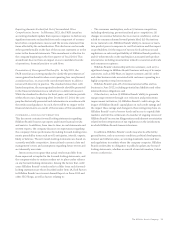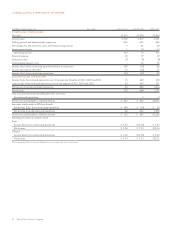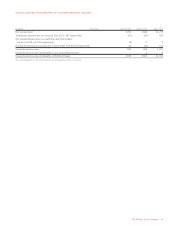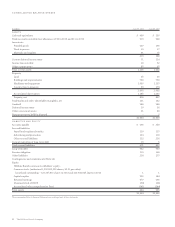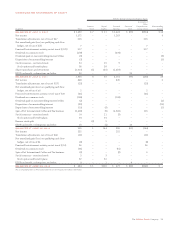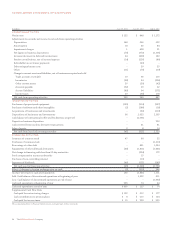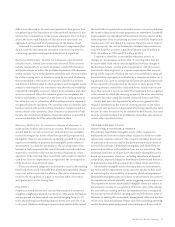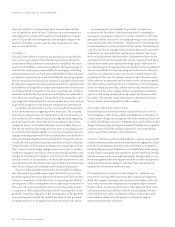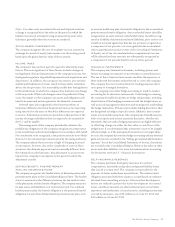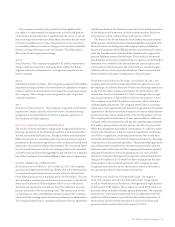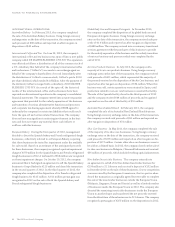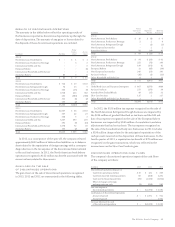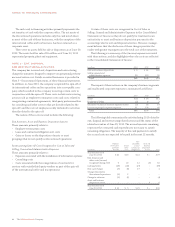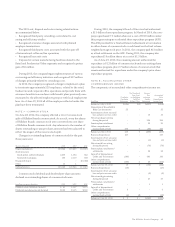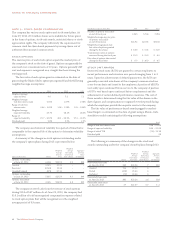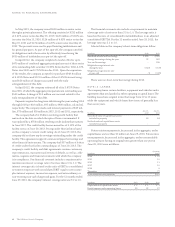Sara Lee 2013 Annual Report Download - page 40
Download and view the complete annual report
Please find page 40 of the 2013 Sara Lee annual report below. You can navigate through the pages in the report by either clicking on the pages listed below, or by using the keyword search tool below to find specific information within the annual report.38 The Hillshire Brands Company
NOTES TO FINANCIAL STATEMENTS
discount cash flows are dependent upon interest rates and the
cost of capital at a point in time. There are inherent assumptions
and judgments required in the analysis of intangible asset impair-
ment. It is possible that assumptions underlying the impairment
analysis will change in such a manner that impairment in value
may occur in the future.
GOODWILL
Goodwill is the difference between the purchase price and the fair
value of the assets acquired and liabilities assumed in a business
combination. When a business combination is completed, the assets
acquired and liabilities assumed are assigned to the reporting unit or
units of the company given responsibility for managing, controlling
and generating returns on these assets and liabilities. Reporting units
are business components at or one level below the operating segment
level for which discrete financial information is available and reviewed
by segment management. In many instances, all of the acquired assets
and liabilities are assigned to a single reporting unit and in these cases
all of the goodwill is assigned to the same reporting unit. In those
situations in which the acquired assets and liabilities are allocated to
more than one reporting unit, the goodwill to be assigned to each
reporting unit is determined in a manner similar to how the amount
of goodwill recognized in the business combination is determined.
Goodwill is not amortized; however, it is assessed for impairment
at least annually and as triggering events may occur. The company
performs its annual review for impairment in the fourth quarter of
each fiscal year. The company uses accounting standards regarding
goodwill impairment reviews that permit an entity to first assess
qualitative factors to determine whether it is more likely than not
that the fair value of a reporting unit is less than its carrying amount
as a basis for determining whether it is necessary to perform the two-
step goodwill impairment test. The more-likely-than-not threshold is
defined as having a likelihood of more than 50%. Some of the factors
considered in the qualitative assessment process were the overall finan-
cial performance of the business including current and expected cash
flows, revenues and earnings; changes in macroeconomic or industry
conditions; changes in cost factors such as raw materials and labor; and
changes in management, strategy or customers. If, after assessing the
totality of events or circumstances, an entity determines that it is not
more likely than not that the fair value is less than the carrying amount,
then the two-step process of impairment testing is unnecessary.
However, if the qualitative assessment discussed above indicates
that there may be a possible impairment then the first step of the
goodwill impairment test is required to be performed.The first step
involves a comparison of the fair value of a reporting unit with its
carrying value. If the carrying value of the reporting unit exceeds its
fair value, the second step of the process is necessary and involves
a comparison of the implied fair value and the carrying value of the
goodwill of that reporting unit. If the carrying value of the goodwill
of a reporting unit exceeds the implied fair value of that goodwill,
an impairment loss is recognized in an amount equal to the excess.
In evaluating the recoverability of goodwill, it is necessary
to estimate the fair values of the reporting units. In making this
assessment, management relies on a number of factors to discount
anticipated future cash flows, including operating results, business
plans and present value techniques. The fair value of reporting units
is estimated based on a discounted cash flow model. The discounted
cash flow model uses management’s business plans and projections
as the basis for expected future cash flows for the first three years
and a residual growth rate thereafter. Management believes the
assumptions used for the impairment test are consistent with those
utilized by a market participant performing similar valuations for
our reporting units. A separate discount rate derived from published
sources was utilized for each reporting unit. Rates used to discount
cash flows are dependent upon interest rates, market-based risk
premium and the cost of capital at a point in time. Because some
of the inherent assumptions and estimates used in determining the
fair value of these reporting units are outside the control of manage-
ment, including interest rates, market-based risk premium, the cost
of capital, and tax rates, changes in these underlying assumptions
and our credit rating can also adversely impact the business units’
fair values. The amount of any impairment is dependent on these
factors, which cannot be predicted with certainty.
EXIT AND DISPOSAL ACTIVITIES
Exit and disposal activities primarily consist of various actions to
sever employees, exit certain contractual obligations and dispose of
certain assets. Charges are recognized for these actions in the period
in which the liability is incurred. Adjustments to previously recorded
charges resulting from a change in estimated liability are recognized
in the period in which the change is identified. Our methodology
used to record these charges is described below.
Severance Severance actions initiated by the company are generally
covered under previously communicated benefit arrangements, which
provides for termination benefits in the event that an employee is
involuntarily terminated. Liabilities are recorded under these arrange-
ments when it is probable that employees will be entitled to benefits
and the amount can be reasonably estimated. This generally occurs
when management with the appropriate level of authority approves
an action to terminate employees who have been identified and
targeted for termination within one year.
Noncancelable Lease and Contractual Obligations Liabilities are
incurred for noncancelable lease and other contractual obligations
when the company terminates the contract in accordance with con-
tract terms or when the company ceases using the right conveyed
by the contract or exits the leased space. The charge for these items
is determined based on the fair value of remaining lease rentals
reduced by the fair value of estimated sublease rentals that could
reasonably be obtained for the property, estimated using an
expected present value technique.



